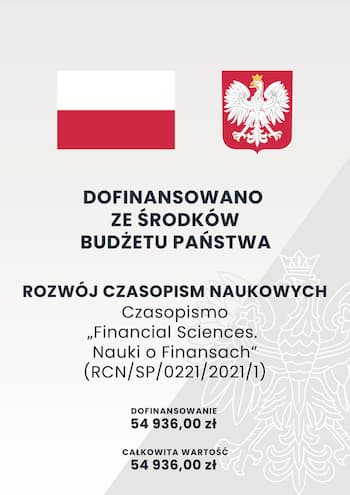Issues
Click a year to expand it.
40 Points
on Ministry of Education and Science journal evaluation list of 2024

Search results for query: Fałat-Kilijańska
Sort by: Relevance Author: Ascending Descending Year: Ascending Descending
- Determinants of the financing structure of the acquiring companies in the pre-merger period. Results of the research
Author: Ilona Fałat-Kilijańska, Jana Gláserová, Piotr Luty, Milena Otavová
See Issue Contents: fins.2020.4
Abstract:The article’s main objective is to identify the factors influencing the financing structure and capital changes in the pre-merger periods in the acquiring companies. The authors examined the relations between various industries and different size companies. Based on the analyses, it can be concluded that in small companies, the explanatory variables identified based on the literature review were statistically insignificant in many periods (in fact almost all). Completely different behaviour was observed in the group of large companies, where the same set of explanatory variables was statistically significant. The result of the research on the existence of non-linear relationships between company parameters is that in the case of some variables, there is no question of a linear nature of dependence. The study analysed the five years preceding the mergers of 307 business entities. The source of the survey data was the database prepared by the company InfoCredit SA for the Accountants Association in Poland. The authors used Statistica software and inductive reasoning for the study – supported by Spearman’s rank correlation analysis, linear and polynomial regression analysis, and variable scatter analysis
- Heteroskedasticity in excess Bitcoin return data: Google trend vs. GARCH effects
Author: Chamil W. Senarathne, Tijana Šoja
See Issue Contents: fins.2019.3
Abstract:This paper examines the mixture of distribution properties associated with heteroskedastic excess Bitcoin return data, using the volume of Google search queries as a proxy for the information arrival time, from a monthly data sampling period of June 2010 to May 2019. The results show that the volatility coefficients become highly statistically insignificant when the lagged volume of search queries is included in the conditional variance equation of the GJR-GARCH-M model. This clearly suggests that the volume of search queries is shown to provide significant explanatory power regarding the variance of heteroskedastic excess Bitcoin return, which can be traced from the ARCH process defined in the GJR-GARCH-M specification. A significant negative relationship between the conditional volatility and the volume of search queries indicates that Internet (online) information arrival reduces the risk premium in the Bitcoin market, which may improve market stability
- Are religious believers irrational: a direct test from an efficient market hypothesis
Author: Chamil W. Senarathne
See Issue Contents: fins.2020.1
Abstract:The current literature does not offer a quantitative test of the irrational behaviour of people, especially taking a proxy for irrationality with reference to an economic activity. This paper examines the role of religious believers in carrying out economic activities. The form of stock market efficiency has been taken as a proxy for testing the null hypothesis that religious believers are irrational on average. The findings suggest that equity markets in religious countries are inefficient at ‘weak form’ level. This provides prima facie evidence for the hypothesis that religious believers are irrational on average. As such, the equity price changes of these stock markets can be forecast on the basis of past patterns. Poor income level and education are the main causes for developing irrationality. As these irrationalities cost economies, the policymakers should design and implement more robust policies and guidelines for poverty alleviation and the enrichment of education at country level
Newsletter






